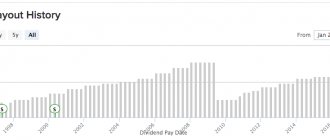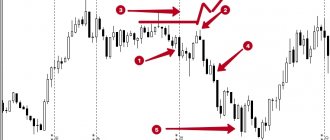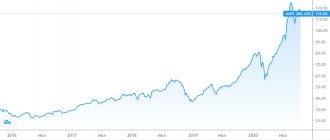Today’s topic is devoted to how to distinguish a trend from consolidation (flat, sideways). The 3 tactics that Neil Fuller introduces us to will certainly help to understand and dispel all doubts in the subsequent analysis of Forex charts. We will also look at whether it is possible to trade in consolidation and how to do it correctly.
One of the most important actions a price action trader must take when analyzing a chart is determining the state of the market. Understanding that there is now a trend or consolidation determines the approach to the market and the choice of trading strategy.
This article will be of interest to novice traders for a better understanding of how to distinguish a trending market chart from a consolidating one.
What is consolidation or flat?
Consolidation in Forex is a state of the market when it is sandwiched between support and resistance. This condition means that a certain state of balance has arisen in the market between sellers or buyers, that is, demand has balanced supply. In other words, the market is in a state of accumulation or distribution. According to statistics, approximately 80% of the time markets are in a flat state, so trading in a sideways range will always be profitable for traders.
For consolidation to become obvious, the price must touch the support and resistance level at least twice.
Consolidations can expand and contract.
An expanding consolidation occurs when price falsely breaks out and moves back into the range, thereby expanding the space between support and resistance. Selling at resistance will force you to get stopped as the price breaks the current resistance level and then returns to the range again.
A contraction consolidation occurs when the market enters a period of low volatility, usually due to an impending news release.
During periods of narrow consolidation, it is better to refrain from entering the market and making trades. But during periods of broad consolidation, you can trade from its borders. This will give us good risk/reward potential. However, you should always remember that sooner or later the price will go beyond the range, a true breakout of the level will occur, and the market will enter the trend phase.
The longer the market is in a flat, the stronger the trend will be after the price leaves the range. Any calm movement in Forex is replaced by an explosive one, and vice versa.
Examples of splits
Apple is perhaps one of the world record holders for the number of splits conducted. Share prices are constantly rising, and the corporation periodically conducts stock splits to make them more accessible to private investors. So, Apple carried out a split in 1987, 2000, 2005, 2014 and 2021. The last time the split was carried out with a ratio of 4:1, i.e. one share was divided into 4. This reduced the share price from 400 to 100 dollars.
And here’s another interesting article: Which Russian companies are conducting buyback in 2021
By comparison, Apple's first split, in 1987, was a 7:1 split, reducing the share price from $645 to $91.15 per share.
Tesla conducted a split almost on the same day as Apple in 2021. A ratio of 5:1 was chosen for the division. This allowed the share price to be reduced from $2,490 to $480. Moreover, after the split, the price of Tesla rose to the current $700.
Another “record holder” for splits is Microsoft. She held splits in 1987, 1990, 1991, 1992, 1994, 1996, 1998, 1999 and 2003, always with 2:1 odds. In 2003, by the way, along with the last split, Microsoft began paying dividends.
But another representative of the FAANG group - Google - carried out a split only once - in 2014. In this case, the process was carried out over 2 years. The owners of class A shares each received one more class C share. At the same time, class A shares are voting, while class C shares are not (the company's owners and top management still have class B shares in their hands, giving 10 votes).
In Russia, splits are not held so often. One of the most famous is the split of Sberbank shares in 2007. At that time, the price of one ordinary share of Sberbank exceeded 100,000 rubles (for comparison: Gazprom then cost about 250 rubles, and Norilsk Nickel - those were the days! - 5,000 rubles). The split was carried out in the ratio of 1000:1 for ordinary shares and 20:1 for preferred shares.
At the same time, in 2007, the split was carried out between Cherkizovo in a ratio of 100:1 and AFK Sistema in a ratio of 1000:1.
And in 2011, Alrosa carried out a split, twice: first in a ratio of 2700.5:1, and then 10:1.
The last time splits were carried out in Russia was in 2015-2016: Russneft and Safmar increased the liquidity of their shares.
Flat is a deposit killer
We have all heard or read on various forums that flat is a killer of trend traders’ deposits. In fact, this is true. If your trading system performs outstandingly in a trending market, then once the sideways movement begins, you can say goodbye to all your profits.
Why does this happen?
The thing is that trend methods will give you signals to enter the market near support and resistance levels, and as soon as you open a buy deal, literally after a couple of points the price hits the level, and after that a reversal begins. On average, the trading system will give 4 false signals, which will completely cover the profits received when trading with the trend. Therefore, if you learn to identify a flat in the early stages of its formation, then the damage caused by it will be minimized, or better yet, you will be able to use this market state to your advantage.
If we try to compare these two market conditions, we will get that the trend is a sprinter, and the flat is an old man whose path from home to the store, and then back, is his favorite.
The concept of consolidation.
An instrument on the market can be either in a trend movement or in consolidation. The trend turns into a flat, just as a trend begins from a flat.
A trend always turns into a flat - and vice versa.
A flat can also be called the accumulation phase, and a trend – the distribution phase. Read an article on this topic: accumulation-distribution.
It is believed that in the accumulation phase, a major player gains his position, and in the distribution phase, accordingly, he distributes. Remember, a big player never enters while moving.
Video on consolidation
Flat on Forex and its characteristics
Sideways price movement has a certain character, which can be described in several points. It is enough to study them, and you will be one step closer to professionalism in determining current conditions on the charts of various currency pairs. So, let's go!
The flat market is passive
It rarely experiences strong, purposeful movements towards one of its boundaries. This price behavior can be explained by uncertainty. None of the participants knows for sure the direction in which the market will move, because every time one of the borders is touched, there is a potential for its breakdown.
Uncertainty
You already know that nothing on the market is 100% accurate. So, the flat zone is a haven for complete confusion, where at least some probability arises only when the price approaches one of the levels, but you cannot say with sufficient confidence that after that it will reach the opposite zone.
Deceptiveness
Sometimes, thoughts arise that the flat has ended, the range has been broken and the price begins to move in the chosen direction. Unfortunately, it's not that simple. Market makers (big guys) know that many newcomers will open orders in the direction of the broken level, therefore, after the breakout, you can observe a reversal movement and a return entry into the flat zone.
The chart above shows an excellent example of a false breakout of the lower boundary followed by a reversal that ended with a breakout of the upper level. Of course it's a shame! No problem, then we’ll figure out how we need to act in such situations.
Tools
Some indicators can also help track price consolidation:
Figure 3 – Trader in action
- Bollinger Bands;
- ADX (Average Direction of Movement Index);
- ATR (Average True Range).
ADX
The ADX indicator was developed as a trend indicator, but has become one of the most popular tools for identifying consolidation. When the indicator on the indicator scale is 25 or higher, there is a pronounced trend in the market. If the indicator is less than 25, then there is a high probability of consolidation.
Bollinger Bands
Although the Bollinger Bands indicator is a trend indicator, many traders also use it to determine market volatility. It is determined simply: if the upper and lower bands diverge, increasing the price channel, then volatility increases, and vice versa.
During consolidation, the price channel becomes very narrow, and the price going beyond its boundaries is clearly visible. But we must take into account that when consolidation occurs immediately after strong price movements, Bollinger Bands become ineffective - although they converge, they are not fast enough to give a clear signal about the completion of price consolidation and the resumption of its movement.
Read more: Autochartist - a professional tool for traders
Oscillators
The purpose of oscillators is to identify overbought/oversold zones of an asset and probable trend reversal points.
Figure 4 – Oscillators in trading
During the period of consolidation, the price moves in a narrow channel, and the areas near its outer boundaries become overbought or oversold zones.
When the price touches the upper or lower border, the probability of it reversing in the opposite direction is quite high.
All oscillators work on the same principle, so there is no fundamental difference which one to use in trading.
The most popular ones are Stochastic and RSI (Relative Strength Index).
But the use of oscillators has one feature - they are not able to adjust depending on the market situation. Those. even in a clearly defined trend, they will show overbought and oversold zones, and give out many signals for a price reversal, most of them false in such a situation.
How to determine a flat?
In order to correctly learn to identify a flat, we must remember what it looks like. A sideways movement is a movement between two highs and lows, perhaps this will be enough. Let's look at the chart and try to identify any price fluctuations between the latest highs and lows.
Blue circles mark the first minimum and maximum. As we can see, the subsequent price movement is contained within the range of the boundaries we have drawn. Next, we can observe how the price breaks through the upper level and an upward trend begins, but it is worth noting that the price before this made 4 rebounds from levels that we could use to make a profit.
Now, let's talk about the main thing. We need to go back to the first chart and find out what we should have done in case of a false breakout, because it is very unpleasant to receive losses due to this kind of situation.
There is no point in being offended by market makers, they were, are and will be. We need to learn to think like them, and also to see what they see. Let's look at an example.
So what do we see? The price breaks through the lower border, but we do not consider the breakout to be true until it confirms its status; we sit and wait. Then the market approaches the broken level, and what can we observe? A bullish Pin Bar was formed on the chart, and even with a long tail, this immediately tells us that there is no point in waiting for confirmation, we open a buy deal, the market begins to grow. It's easy if you have patience.
The value of a split for an investor
There are simply no negative consequences from a split. Simply, on the day of the split, the number of shares in the account increases, and their price decreases several times. So, if a split was carried out with a ratio of 10:1, then the price of the new share is reduced exactly 10 times.
I would even say that the split is a blessing for the investor. So, he will be able to partially fix the profit. Let’s say a certain Vasya bought one share of Kresla for $200, and when it (the share) rose in price to 800, Kresla carried out a 5:1 split. Consequently, Vasya had 5 shares in his account at $160 (the total value of the position was $800).
Now Vasya can partially take profit by selling, for example, 2 or 3 shares, and leaving the rest to grow. If there was no split, you would have to sell one single share, depriving yourself of potential profit.
How to trade in a sideways market?
The best strategy for trading sideways markets is a false breakout. It usually provides a powerful impetus for price movement in the opposite direction. Market makers always collect traders' stop losses at levels to gain liquidity and then move in the opposite direction. This should always be taken into account when trading false breakouts. You can set take profit and exit the trade on the other side of the trading range.
If the market is too chaotic, its trading range is jagged, and the price moves too sharply and volatile, it is best to refrain from trading.
How does a breakout of flat boundaries occur?
We have come to the last part of this article. A sideways movement breakout can be predicted by just knowing what to look for on the chart. Let's look at two main methods.
Method “Reversal through a breakout”
This is exactly what we recently broke down in the chart above. The price breaks through the lower boundary, and instead of testing it, it returns to the zone. This market behavior signals us about a potential breakout of the opposite level, and we have a chance to enter the emerging trend at the best prices. You can see what it should look like above.
Incomplete Completion Method
This name refers to the price shortfall to the opposite level. This happens because certain forces (bears or bulls) took control of the market without waiting to touch “their” border. Therefore, as soon as we see that the price has only reached the middle of the flat zone or has traveled only 1/3 of the intended path, we must be ready to open trades in the direction of the reversal. On the graph, it looks like this.
You can see how the price began its decline from the resistance level, but without touching the support, it began a reversal, which led to a breakdown of the upper border. After this, an upward trend emerged.
Trading on a rebound from the boundaries of the trading range
A rebound from consolidation boundaries is one of the best and most profitable trading setups in the price action system. There are several reasons that make range trading potentially beneficial for a trader. Let's look at the nuances and features of rebound trading.
Possible profit
The great thing about price action trading is the flexibility it offers. Price action can successfully fit into a variety of trading styles and offers many opportunities to customize your trading.
Consolidations can occur on different timeframes - H1, H4, D1. In most ranges you can successfully open at least two trades and even more.
On H4 you can expect to make an average of 40 pips per trade, which over two trades will give you around 80 pips in profit. If a trading range forms on the daily chart, you can gain an average of 80 pips per trade. Thus, by making just 2 trades on the daily chart, you can make more than 160 pips of profit.
The profitability of trading ranges is unmatched. The main thing is to be able to open a deal on time.
Reliability
Consolidations provide ideal profit opportunities because they form between support levels and resistance areas, which are themselves buying and selling zones. Thus, when the price moves up, it enters the sell zone. When the price moves down, it enters the buy zone.
This gives us reliable points to enter the market. Let's look at some examples.
Above you can see a chart of the USD/CAD currency pair, which was in a range. The dotted line on the chart is the psychological level of 1.0000. This range had several trading opportunities that could be taken advantage of.
The reversal trading strategy was described in detail in the article Price Action Strategy for Beginners: Trading Reversal Setups. The basic idea is to find a directional move followed by an uncertainty candle at a support or resistance level.
I highlighted 5 rebounds that formed in the USD/CAD consolidation zone. Of the 5 trades, only the first one was unsuccessful. Since the trading range of the currency pair is 80 points, we can take 60 points of profit in rebound trades.
Trading strategy
You should focus on support zones (places to buy) and resistance zones (places to sell). Once the price reaches these areas, you can look for opportunities to open positions. Once your position is opened, you need to select the other side of the range to achieve your target profit.
If the price reaches your target, you can immediately enter a trade in the opposite direction. Trading consolidations is incredibly easy and requires minimal investment if you do it right.
Determining the range is simple. You just need to find two bounces from the support level and two bounces from the resistance level. When they occur, you will know that the range has been confirmed and you can enter the market.
Theoretically, you can enter at every touch from support or resistance levels, but this will be too dangerous. You will never be able to know when the price will leave the zone and breakout the level. If you are only looking for hopeful trade setups forming in buy or sell zones, pay attention to the price action patterns that should appear at the levels.











